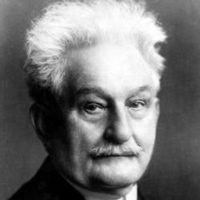
Janáček
Born: 1854
Died: 1928
Leoš Janáček
Janáček was 62 when the world of music discovered him. He had 12 more years to live and, though he had not stopped composing after the initial triumph of Jenůfa, an intense period of creative activity ensued including the production of the Glagolitic Mass, the Sinfonietta and two extraordinary string quartets.
Explore Janáček's life and music...
Inside Janáček’s Glagolitic Mass
Conductor Tomáš Netopil talks to Hannah Nepil about finding the true spirit of Janáček... Read more
Top 10 Janáček recordings
In any gathering of the finest recordings of Janáček's music, one particular conductor's name is always bound to loom large... Read more
The ninth of 14 children, Janáček was brought up in the magnificent mountains and forests of north-eastern Moravia on the Polish border. When he was 11, his father, the village schoolmaster, decided to send him to the Augustine monastery in Brno, the Moravian capital, where the choirmaster was a family friend. From there Janáček graduated to the Brno Teachers’ Training College (1872-74), the Organ School (College of Music) in Prague (1874-75), thence to the Leipzig and Vienna Conservatories. He returned to Brno, married and settled into teaching and conducting locally.
Like Bartók and Kodály in Hungary, like Vaughan Williams and Holst in England, Janáček became fascinated by his country’s folk music and set off with a friend (František Bartoš) to collect folk material. Certain elements of this found its way into his early compositions; he evolved a theory that music should follow the rhythms of human speech, of animal and bird noises. For the next 20 years, Janáček continued to live and work in Brno in total obscurity, writing no music of any significance.
It wasn’t till his late forties that he found his own distinctive voice in his opera Jenůfa. It was first performed in Brno just before Janáček’s 50th birthday. It took another 12 years to reach Prague. In other words, Janáček was 62 when the world of music discovered this unorthodox and original composer. He had 12 more years to live and, though he had not stopped composing after the initial triumph of Jenůfa, an intense period of creative activity ensued including the production of the Glagolitic Mass, the Sinfonietta and two extraordinary string quartets. The foundation of the Czech republic in 1918, along with freedom from German domination and his love of Russia and the Russian language provided spurs to his endeavours.
A further catalyst was Janáček’s love life. In 1917 he had an affair with one of the singers in the Prague production of Jenůfa and the next year met Kamila Stösslová, the pretty wife of an antiques dealer. Her husband had been able to provide food for the Janáčeks during the war and Janáček was later in a position to save the Stössls from being expelled as aliens. He became infatuated with Kamila (he’d separated from his wife) and began a voluminous correspondence in the last 16 months of his life amounting to nearly 700 letters. Kamila did not reciprocate his feelings but Janáček transformed her into the heroine of three of his final works – Kát’a Kabanová, The Cunning Little Vixen and The Makropulos Affair. She was also the inspiration for his song-cycle The Diary of One Who Disappeared. His creative urges were undiminished when he caught a cold after a walk in the woods near his home village. This turned into bronchial pneumonia from which he died aged 74.

Gramophone Digital Club
- Digital Edition
- Digital Archive
- Reviews Database
- Full website access
From £8.75 / month
Subscribe
Gramophone Full Club
- Print Edition
- Digital Edition
- Digital Archive
- Reviews Database
- Full website access
From £11.00 / month
Subscribe
If you are a library, university or other organisation that would be interested in an institutional subscription to Gramophone please click here for further information.





